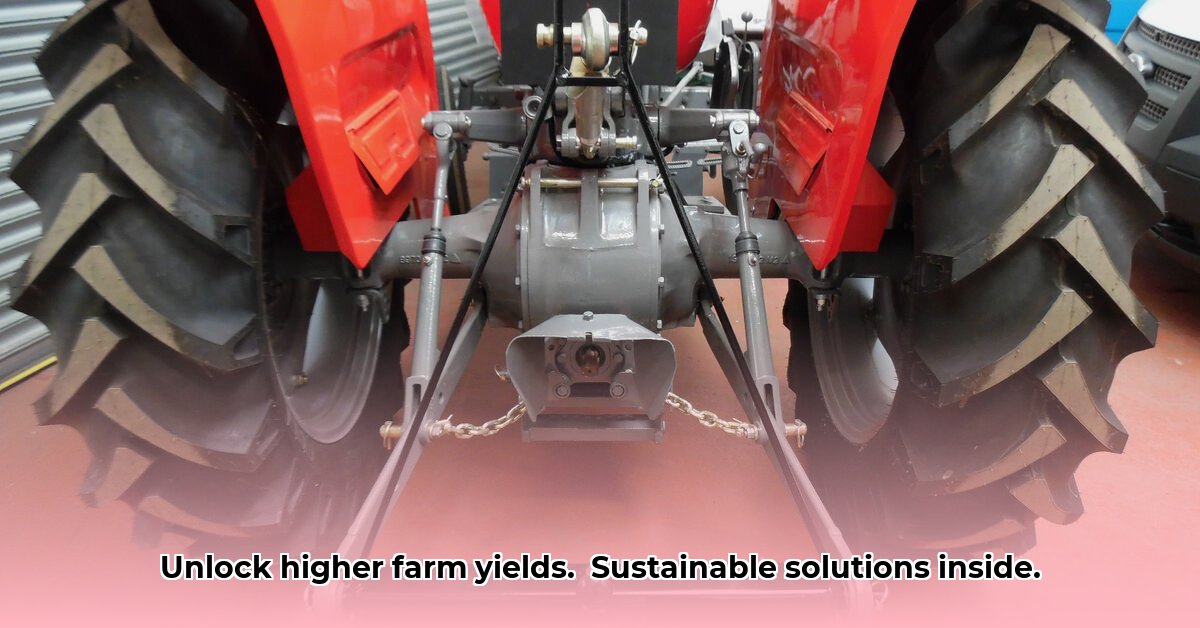
Choosing the Right Tow Bar for Sustainable Farming
Efficient and sustainable farming practices require reliable equipment, and the tow bar is often an overlooked yet crucial component. Selecting the appropriate tow bar for your tractor significantly impacts operational efficiency, fuel consumption, and overall farm sustainability. This guide helps you choose the best tow bar for your specific needs. For more information on farm equipment, check out this helpful resource: Farm Equipment Guide.
Understanding Your Towing Needs
Before selecting a tow bar, several factors must be considered to ensure safety and efficiency:
Tractor Capacity: Never exceed your tractor's maximum towing capacity, clearly stated in your owner's manual. Overloading can lead to serious damage and injury. This is paramount for safe operation.
Load Weight: Accurately estimate the weight of the implement you’ll be towing. Different implements (plows, harrows, etc.) vary significantly in weight. Overestimating is always safer than underestimating the weight.
Terrain Conditions: The terrain significantly impacts tow bar selection. Rough or hilly terrain necessitates a more robust tow bar than flat fields, to prevent bending or breakage. This helps ensure operational reliability.
Safety: Choosing the right tow bar is crucial for preventing accidents, equipment damage, and crop loss. Ensuring a secure connection is vital for safety purposes.
Types of Tow Bars: A Detailed Comparison
Several types of tow bars cater to different needs and load capacities:
Pintle Hooks: These are simple, relatively inexpensive, and suitable for lighter loads. They are ideal for smaller implements and less demanding tasks.
Drawbars: Designed for heavier implements and more demanding tasks, drawbars offer enhanced stability and strength. They are the preferred choice for larger equipment.
Specialized Tow Bars: Certain applications might require specialized tow bars designed for unique terrains or tasks. These are application-specific and may offer additional benefits.
Always consult your tractor's owner's manual for compatible tow bar types and capacities; this is crucial for ensuring correct functionality and safe operation.
Best Practices for Safe and Efficient Towing
Safe towing involves both proper equipment selection and adherence to best practices:
Pre-Tow Inspection: Before each use, thoroughly inspect the tow bar and implement for any damage (cracks, bends, loose bolts). This prevents potential breakdowns during operation.
Secure Connections: Ensure all connections between the tow bar, tractor, and implement are secure and tight. Double-check to prevent unexpected disconnections.
Even Weight Distribution: Evenly distribute the weight to reduce stress on any single point. Overloading significantly increases the risk of damage.
Controlled Speed: Maintain a slow and steady speed, particularly on uneven terrain or inclines. Avoid sudden braking or acceleration.
Visibility: Ensure good visibility, using lights and reflectors, particularly in low-light conditions. This enhances safety for both the operator and anyone nearby.
Terrain Awareness: Exercise extreme caution when towing on uneven, inclined, or soft ground. These conditions drastically increase risk.
Regular Maintenance: Regularly lubricate moving parts and inspect for wear and tear, replacing worn components promptly. Preventative maintenance is a key feature of sustained operation.
Did you know that proper tow bar use can reduce fuel consumption by up to 15%? This translates to significant savings and a smaller environmental footprint.
Tow Bar Maintenance for Extended Lifespan
Regular maintenance extends the lifespan of your tow bar:
Lubrication: Regularly lubricate moving parts according to the manufacturer's recommendations. This minimizes wear and tear.
Inspection: Regularly inspect for signs of wear, damage, or stress. Address minor issues promptly to prevent them from escalating.
Storage: Store the tow bar in a dry, protected area when not in use to prevent corrosion and damage. This ensures that the equipment is protected.
Connecting Tow Bars and Sustainable Farming Practices
The correct use of a tow bar significantly contributes to sustainable farming:
Fuel Efficiency: Efficient towing techniques minimize fuel consumption, reducing your carbon footprint.
Reduced Emissions: Less fuel use directly translates to lower greenhouse gas emissions.
Extended Equipment Lifespan: Proper maintenance and usage prolong the life of the tow bar, reducing waste and saving money.
Improved Operational Efficiency: A well-functioning tow bar contributes to smoother operations, enabling better efficiency.
Dr. Emily Carter, Agricultural Engineer at the University of California, Davis, states, "Investing in high-quality tow bars and following proper maintenance practices is a crucial aspect of sustainable agriculture, contributing to both economic and environmental benefits."
Troubleshooting Common Tow Bar Problems
Connection Issues: If the tow bar doesn't connect easily, check compatibility and remove any debris from connections.
Loose Connections: Immediately tighten any loose connections; a loose connection is a serious safety hazard.
Bending or Breaking: Bending or breaking often indicates overloading. Reduce the load immediately and replace the damaged tow bar if needed.
By understanding and implementing these guidelines, you will enhance your farm’s efficiency, sustainability, and profitability. Proper tow bar selection and maintenance are essential for modern farming practices.